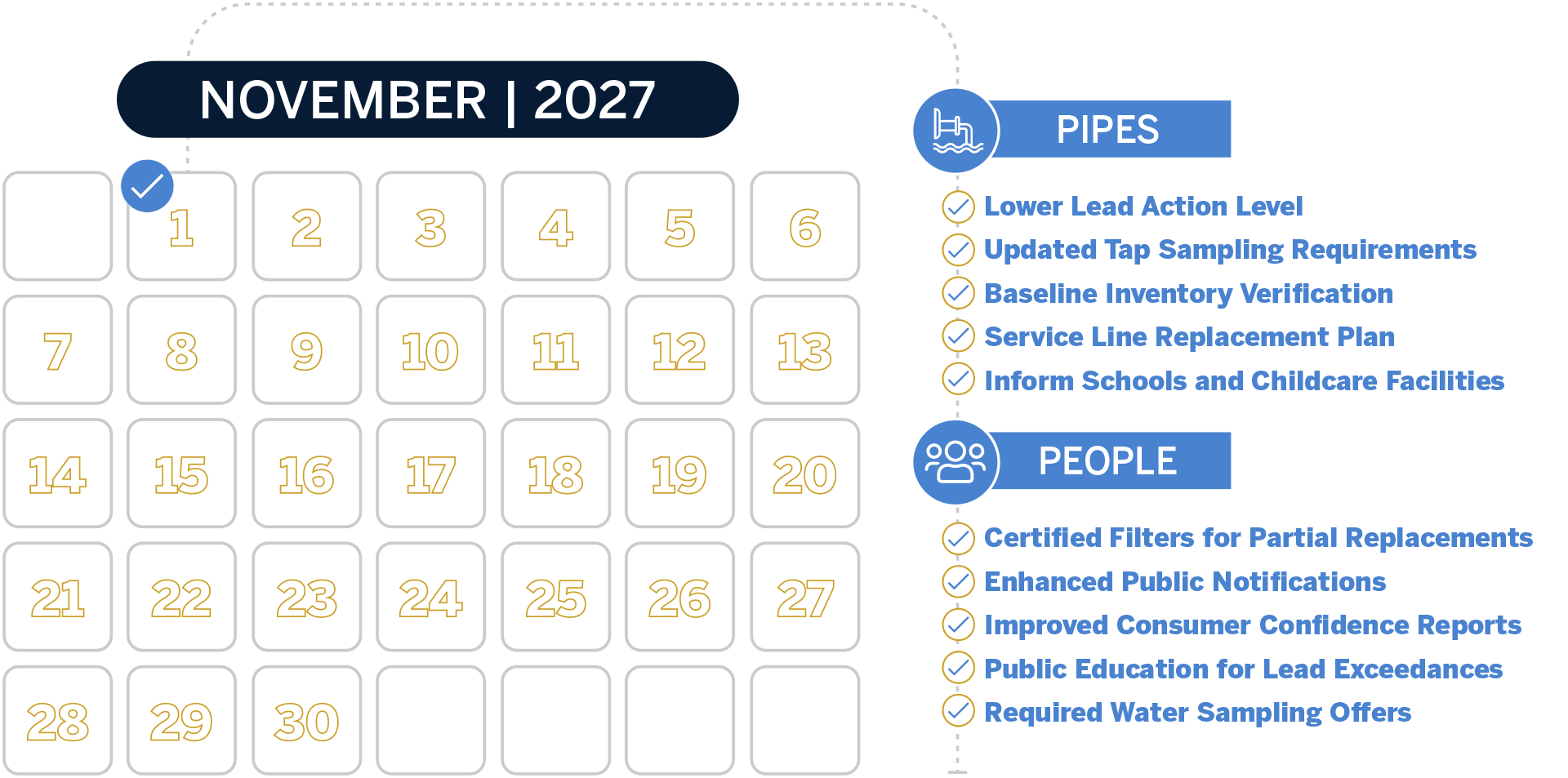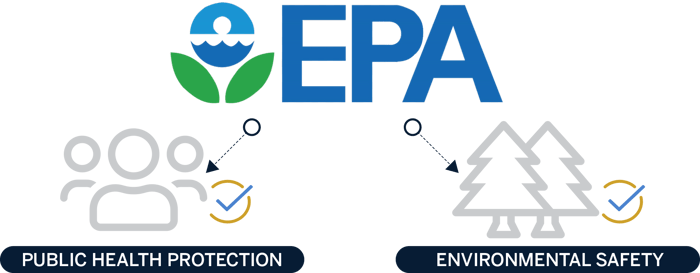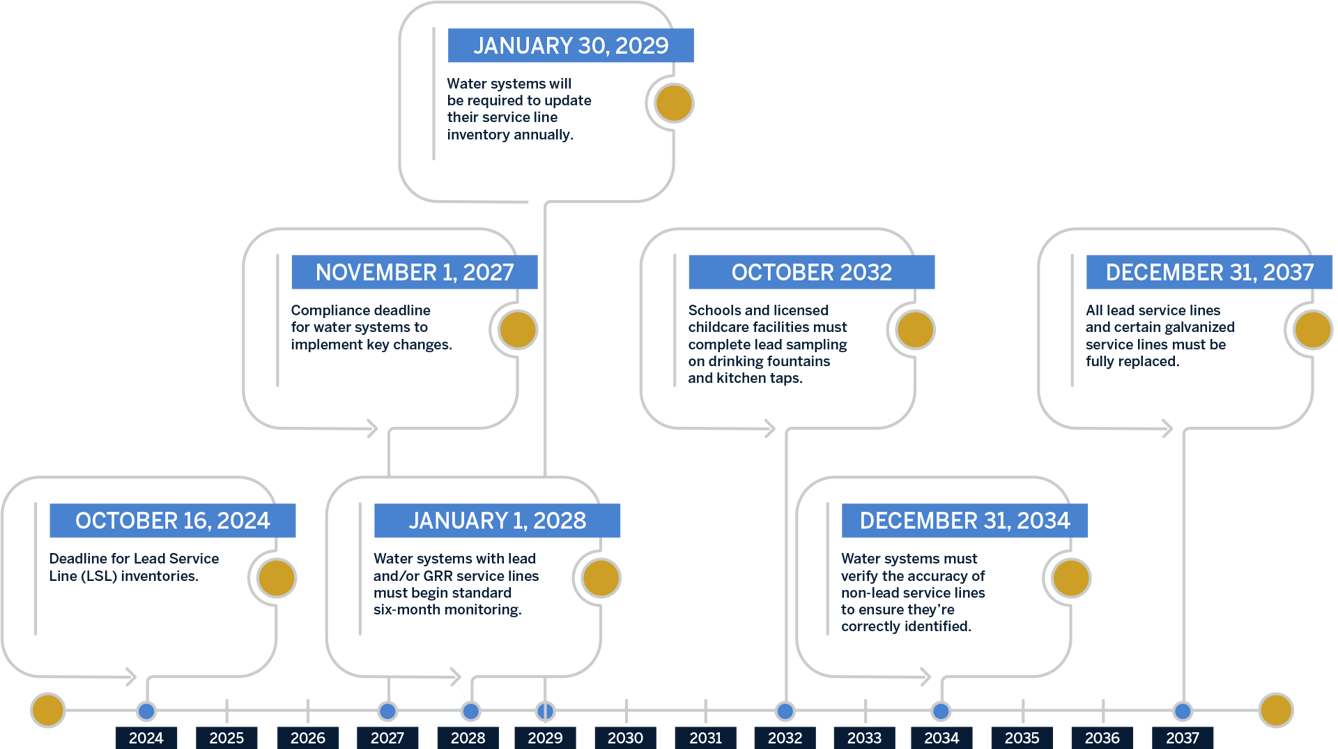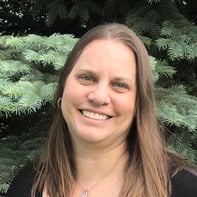We’ve officially crossed a major milestone: the October 16, 2024, deadline for Lead Service Line (LSL) inventories has come and gone.
Water systems nationwide stepped up to map their lead infrastructure, and now it’s time to roll up our sleeves for the next phase in the journey to cleaner, safer drinking water. The Final Lead and Copper Rule Improvements (LCRI) isn’t just a regulatory checklist; it’s a game plan for protecting communities from lead exposure and ensuring a healthier future.
What’s on Deck After the Initial Inventory Phase?

With the LSL inventories in hand, water systems must now transition from identification to action. Staying ahead of these deadlines will require proactive planning, from updating sampling protocols to ensuring the accuracy of the service line inventories. Here’s what water systems need to know to remain compliant and safeguard their communities:
Compliance by November 1, 2027

By this deadline, water systems must have implemented several significant changes:
- Lower Lead Action Level: The action level for lead has dropped from 15 µg/L to 10 µg/L. That means systems that previously passed with borderline results are now required to take corrective action, such as optimizing corrosion control treatment or replacing lead service lines. This change highlights the EPA’s commitment to stricter public health standards and represents the strongest rule on lead in drinking water the agency has issued to date.
- Updated Tap Sampling Requirements: The LCRI now requires both first-liter and fifth-liter samples, ensuring a more accurate read on lead levels. Water utilities must use the higher result between the two, which might feel like doubling down, but it’s all about getting the clearest picture of water quality. Sampling must prioritize sites with lead service lines, galvanized lines downstream of lead, or premise plumbing made of lead.
- Baseline Inventory Verification: Water systems must update their initial service line inventory, verifying known and unknown service lines.
- Service Line Replacement Plan: A detailed plan is required for systems with lead, galvanized requiring replacement (GRR), or unknown service lines, outlining how and when replacements will be completed.
- Inform Schools and Childcare Facilities: Community water systems (CWSs) are required to notify elementary schools and licensed childcare facilities that they are eligible for sampling, providing the EPA's "3Ts" guidance – Training, Testing, and Taking Action – to help manage exposure.
This next phase isn’t just about the pipes; it’s about people. Communities can expect stronger protections and clearer communication with the addition of the following requirements:
- Certified Filters for Partial Replacements: Certified filters or point-of-use (POU) devices must be provided in cases of partial lead service line replacement to minimize exposure risks.
- Enhanced Public Notifications: Systems must notify consumers within 24 hours of any disturbances to lead service lines and provide instructions to reduce lead exposure.
- Improved Consumer Confidence Reports: Updates to these reports include clearer language on lead risks, details on water systems’ replacement plans, and specific guidance for reducing exposure.
- Public Education for Lead Exceedances: Water systems must deliver educational materials to every service connection address, not just bill-paying customers, and provide targeted messaging for vulnerable groups such as pregnant women or children.
- Required Water Sampling Offers: Community water systems (CWS) must offer lead sampling for households if they exceed the action level exceedance (ALE) or if the home is served by a lead, galvanized requiring replacement (GRR), or unknown service line.

These next steps reflect the EPA’s commitment to its overarching values of public health protection and environmental safety. However, it’s important to note that some states are taking this a step further. For example, Wisconsin recently lowered its blood lead poisoning intervention threshold to 3.5 µg/dL, aligning with the CDC’s updated 2021 guidelines. This stricter standard highlights how states can adapt federal rules to address specific local challenges, creating even stronger safeguards for their communities.
Important Future Dates

Beginning January 1, 2028, water systems with lead and/or GRR service lines must conduct standard six-month monitoring. Water systems that meet the requirements of the LCRI tap sampling protocols, such as the lower action level, prior to November 1, 2027, can remain on their existing sampling schedule. Then, starting January 30, 2029, systems will be required to update their service line inventories each year moving forward.
Schools and licensed childcare facilities must complete their required lead sampling by October 2032 and additionally by request after this set deadline. This includes testing water from designated fixtures, such as drinking fountains and kitchen taps, to identify potential lead contamination. If elevated lead levels are detected, the facility must take corrective actions, such as fixture replacement, flushing programs, or installing filtration systems. Water systems are responsible for providing sampling guidance and ensuring schools and childcare centers receive timely results and remediation recommendations.
By December 31, 2034, water systems must verify the accuracy of their previously identified non-lead service lines. This process ensures that service lines classified as non-lead are correctly identified and do not pose a risk of lead contamination. Validation methods may include historical records review, physical inspections, excavation, or advanced testing techniques such as predictive modeling and water sampling. Any discrepancies or unverified classifications must be addressed to ensure compliance with the LCRI and to provide communities with confidence in their drinking water infrastructure.
All lead service lines and certain galvanized service lines that are or were previously downstream of lead must be fully replaced by December 31, 2037.
A $2.6 Billion Boost to Get the Job Done

The EPA isn’t leaving water systems to tackle this alone. With $2.6 billion in funding, including significant allocations for communities most in need, there’s real muscle behind the push for cleaner water. To make accessing these funds easier, the EPA has created a dedicated webpage outlining funding sources for lead service line replacement projects. This resource serves as a comprehensive guide for community water systems navigate federal and state funding opportunities, helping them take actionable steps toward eliminating lead contamination in drinking water systems.
Why It Matters
Let’s not forget the stakes here. Lead exposure can impact everything from cognitive development in kids to cardiovascular health in adults. With these improvements, the EPA isn’t just enforcing rules – it’s investing in the health and future of our communities.
You’ve conquered the inventory challenge, and now it’s time to execute. The Final Lead and Copper Rule Improvements aren’t just regulations; they’re a roadmap to a lead-free future. So, here’s to the next chapter where safer drinking water becomes a reality for all. Stay tuned, stay hydrated, and stay lead-free!
About the Experts

Simon McCormack, PE*, has in-depth knowledge of water system engineering from design to operation. He is well-informed about the SDWA, Minnesota Plumbing Code, Minnesota Well Code, and procedures for enforcing these standards. In addition to engineering design and operation, Simon is well-versed in hydraulic modeling and integrating modeling software with GIS systems.
*Registered professional engineer in MN

Katie Kinsey, PE*, is a project engineer with extensive experience in the water industry managing infrastructure projects that includes distribution main and transmission main planning, design, and construction, water distribution system improvement studies, hydraulic modeling, source water well improvements, and water treatment plant improvements. She is experienced in project management, planning, funding procurement, preparation of construction documents, bidding services, and construction observation and administration.
*Registered professional engineer in IA, NE, MN, WI, MO, KS, SD, VA

Kevin Young, PE*, is a dedicated water engineer with experience managing projects including water treatment plant construction and rehabilitation, ground water and surface water supply improvements, water system planning, and hydraulic modeling. As a licensed water operator and professional engineer, Kevin combines technical skills with practical experience to deliver complex projects in both small towns and large metropolitan areas.
*Registered professional engineer in MN and VA

.png?width=113&name=SEH_Logo_RGB%20(1).png)
